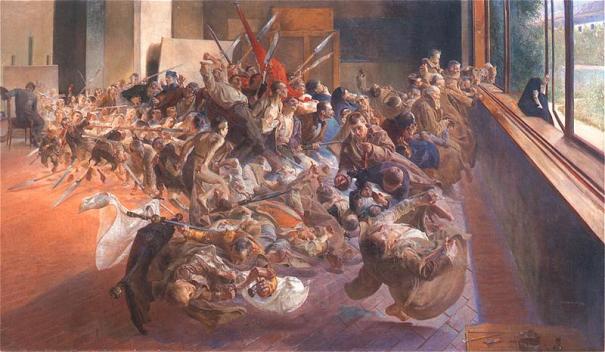About the Artist
Jacek Malczewski
Born: Radom, Poland, 14 or 15 July 1854
Died: Krakow, 8 October 1929
Nationality: Polish

Melancholia
Jacek Malczewski, 1894.
Collection
The National Museum in Poznan
Documentation
In a 1 September 1894 letter to his wife, Maria, Malczewski lamented:
“The [Polish] Republic is quite safe, because it’s dead – it’s no longer of this world…It returns…from time to time, as a welcome apparition, yet with each generation this apparition fades a little more…[becoming] increasingly ethereal and elusive…”
Cited in Elizabeth Clegg, “Faux terrain: Discontinuous Space in the Early Work of Jacek Malczewski,” Zeitschrift für Kunstgeschichte, vol. 53, no. 2 (1990): 206.
Contemporary critic Stanisław Lack, contextualized the work of Malczewski as exemplified by Melancholia:
"One can say that this artist resumed the tradition of fantastic painting. His compositions, sometimes similar to Romantic painting, demand no justification - they influence minds through the power of their voice and color. No one seeks justifications, everyone is captivated and the fantasy is accepted. In these compositions, real objects function like a brake, preventing the imagination from spinning out of control. Imaginary figures appear in Malczewski's canvas: these figures are arranged in groups like particles, yet each remains nameless. Melancholia, or Vicious Circle, as it is commonly known, demonstrates this in a compelling way. A crushing throng of figures spread across the canvas, and the only real figure is outside looking in. No need to ask who this is. The artist describes him precisely: this is the witness to this scene...Some portrayals embody a person's character. But these figures do not bear any precisely identifying elements either in terms of their historical costumes or their features. The artist found them in his imagination and gave each a precise facial expression, movement, and coloring that enables one to distinguish between real and imaginary figures. These imaginary figures - an odd matter - direct the viewer's imagination - the artist doesn't let the viewer fantacize about the persons portrayed - Malczewski expresses himself clearly and forcefully."
Stanisław Lack, "Malczewski," Sztuka Polska, Malartwo, F. Jasienski and A. Łada-Cybulski, eds. (Lwów, 1903-4), np (Translation by Wojtek Kordyzon).
Similar Subjects by Other Artists
Albrecht Dürer, Melancholy, 1513-14 (engraving, numerous collections, including Metropolitan Museum of Art, New York)
Edvard Munch, Melancholy, 1892 (Various versions)